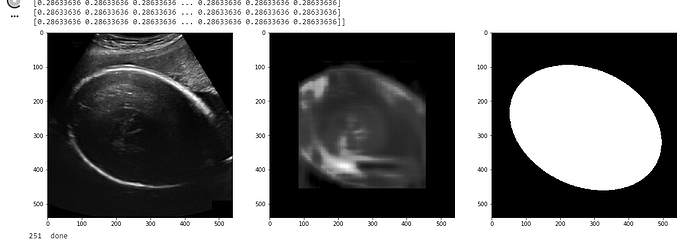how do I change predicted output pixel value which lies between 0 to 1 to binary values 0 or 1 for each pixel in semantic segmentation?
This is how my input, predicted and label image looks like. I want to make the predicted image into black & white.
I am implementing U-net code
My training code:
for epoch in tqdm_notebook(range(num_epochs)):
total_train = 0
correct_train = 0
epoch_loss = 0
DICE = 0
for k,train_img in enumerate(trainLoader):
inputs,labels = train_img
inputs = inputs.cuda();
inputs = inputs.unsqueeze_(0)
inputs = inputs.reshape(batch_size_train,1,img_width,img_height)
labels = labels.unsqueeze_(0)
labels = labels.reshape(batch_size_train,1,img_width,img_height)
model.train(mode=True)
# Forward pass
optimizer.zero_grad() # zeroes the gradient buffers of all parameters
inputs = inputs.cuda()
labels = labels.cuda()
outputs = model(inputs) # outputs.shape =(batch_size, n_classes, img_cols, img_rows)
# inputs = inputs.cuda();
labels = labels.permute(0, 2, 3, 1) # labels.shape =(batch_size, img_cols, img_rows, n_classes)
outputs = outputs.permute(0, 2, 3, 1) # outputs.shape =(batch_size, img_cols, img_rows, n_classes)
m = outputs.shape[0] # m = batch size
width_out = outputs.shape[2]
height_out = outputs.shape[1]
outputs_new = outputs.resize(m*width_out*height_out,1) # Resizing the outputs and label to calculate pixel wise softmax loss
labels_new = labels.resize(m*width_out*height_out,1)
loss = criterion(outputs_new,labels_new)
epoch_loss += loss.item()
loss.backward() # Backward and optimizeuns
optimizer.step() # update gradients
DICE += dice_coeff(outputs[:,:,:,0], labels[:,:,:,0]).item()
labels_new = labels_new.to(dtype=torch.long)
_, predicted = torch.max(outputs_new.data, 1)
total_train += labels_new.nelement() #.nelement returns total no. of elements in input tensor(here it is pixel)
correct_train += predicted.eq(labels_new.squeeze().data).sum().item()
train_accuracy = 100 * correct_train / total_train
if k % 50 == 0:
inputs = inputs.cpu().numpy()
labels = labels.cpu().detach().numpy()
outputs = outputs.cpu().detach().numpy()
f = plt.figure(figsize =(20,20))
f.add_subplot(1,3,1)
plt.imshow( inputs[0,0,:,:] ,cmap = 'gray')
f.add_subplot(1,3,2)
plt.imshow(outputs[0,:,:,0] ,cmap='gray')
f.add_subplot(1,3,3)
plt.imshow( labels[0,:,:,0] ,cmap='gray')
plt.show()
if k ==1:
break
if (epoch % 1 == 0):
print('Epoch [{}/{}],Loss: {:.4f},DICE:{:.4f} '.format(epoch+1,num_epochs,(epoch_loss / k),DICE / (k + 1)),"Training Accuracy: %d %%" % (train_accuracy))
print()
#
also, do I need to use hot encoder vector method to solve this problem.
